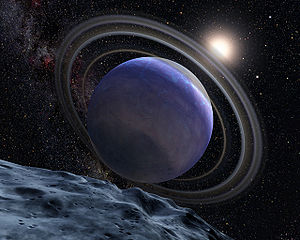
HR 8799 b
Encyclopedia
HR 8799 b is an extrasolar planet
located approximately 129 light-year
s away in the constellation
of Pegasus
, orbiting the 6th magnitude
Lambda Boötis star
HR 8799
. It has a mass between 4 and 7 Jupiter mass
es and a radius from 10 to 30% larger than Jupiter
's. It orbits at 68 AU from HR 8799 (or 7 AU inside the inner edge of the dust disk orbiting the star) with an unknown eccentricity and a period of 460 years, and is the outermost known planet in the HR 8799 system. Along with two other planets orbiting HR 8799, the planet was discovered on November 13, 2008 by Marois et al., using the Keck and Gemini observatories
in Hawaii
. These planets were discovered using the direct imaging technique.
 In 2009 it was discovered that the Hubble Space Telescope
In 2009 it was discovered that the Hubble Space Telescope
had in fact directly imaged HR 8799 b eleven years earlier, in 1998, suggesting that more exoplanets might be revealed through analysis of HST photographic archives. Additional precovery images were also obtained by reanalyzing data taken in 2002 at the Subaru Telescope, and in 2004 and 2007 at the W.M Keck Observatory.
Near infrared H band and K band spectroscopy of HR8799b published in March 2011 indicate a hydrogen rich, dusty atmosphere with disequilibrium CO / CH4 chemistry.
Extrasolar planet
An extrasolar planet, or exoplanet, is a planet outside the Solar System. A total of such planets have been identified as of . It is now known that a substantial fraction of stars have planets, including perhaps half of all Sun-like stars...
located approximately 129 light-year
Light-year
A light-year, also light year or lightyear is a unit of length, equal to just under 10 trillion kilometres...
s away in the constellation
Constellation
In modern astronomy, a constellation is an internationally defined area of the celestial sphere. These areas are grouped around asterisms, patterns formed by prominent stars within apparent proximity to one another on Earth's night sky....
of Pegasus
Pegasus (constellation)
Pegasus is a constellation in the northern sky, named after the winged horse Pegasus in Greek mythology. It was one of the 48 constellations listed by the 2nd century astronomer Ptolemy, and remains one of the 88 modern constellations.-Stars:...
, orbiting the 6th magnitude
Apparent magnitude
The apparent magnitude of a celestial body is a measure of its brightness as seen by an observer on Earth, adjusted to the value it would have in the absence of the atmosphere...
Lambda Boötis star
Lambda Boötis star
A Lambda Boötis star is a type of peculiar star which has an unusually low abundance of iron peak elements in its surface layers. One possible explanation for this is that it is the result of accretion of metal-poor gas from a circumstellar disc. The prototype is Lambda Boötis....
HR 8799
HR 8799
HR 8799 is a young main sequence star located 129 light years away from Earth in the constellation of Pegasus, with roughly 1.5 times the Sun's mass and 4.9 times its luminosity. It is part of a system that also contains a debris disk and at least four massive planets...
. It has a mass between 4 and 7 Jupiter mass
Jupiter mass
Jupiter mass , is the unit of mass equal to the total mass of the planet Jupiter . Jupiter mass is used to describe masses of the gas giants, such as the outer planets and extrasolar planets. It is also used in describing brown dwarfs....
es and a radius from 10 to 30% larger than Jupiter
Jupiter
Jupiter is the fifth planet from the Sun and the largest planet within the Solar System. It is a gas giant with mass one-thousandth that of the Sun but is two and a half times the mass of all the other planets in our Solar System combined. Jupiter is classified as a gas giant along with Saturn,...
's. It orbits at 68 AU from HR 8799 (or 7 AU inside the inner edge of the dust disk orbiting the star) with an unknown eccentricity and a period of 460 years, and is the outermost known planet in the HR 8799 system. Along with two other planets orbiting HR 8799, the planet was discovered on November 13, 2008 by Marois et al., using the Keck and Gemini observatories
Gemini Observatory
The Gemini Observatory is an astronomical observatory consisting of two telescopes at sites in Hawai‘i and Chile. Together, the twin Gemini telescopes provide almost complete coverage of both the northern and southern skies...
in Hawaii
Hawaii
Hawaii is the newest of the 50 U.S. states , and is the only U.S. state made up entirely of islands. It is the northernmost island group in Polynesia, occupying most of an archipelago in the central Pacific Ocean, southwest of the continental United States, southeast of Japan, and northeast of...
. These planets were discovered using the direct imaging technique.

Hubble Space Telescope
The Hubble Space Telescope is a space telescope that was carried into orbit by a Space Shuttle in 1990 and remains in operation. A 2.4 meter aperture telescope in low Earth orbit, Hubble's four main instruments observe in the near ultraviolet, visible, and near infrared...
had in fact directly imaged HR 8799 b eleven years earlier, in 1998, suggesting that more exoplanets might be revealed through analysis of HST photographic archives. Additional precovery images were also obtained by reanalyzing data taken in 2002 at the Subaru Telescope, and in 2004 and 2007 at the W.M Keck Observatory.
Near infrared H band and K band spectroscopy of HR8799b published in March 2011 indicate a hydrogen rich, dusty atmosphere with disequilibrium CO / CH4 chemistry.

